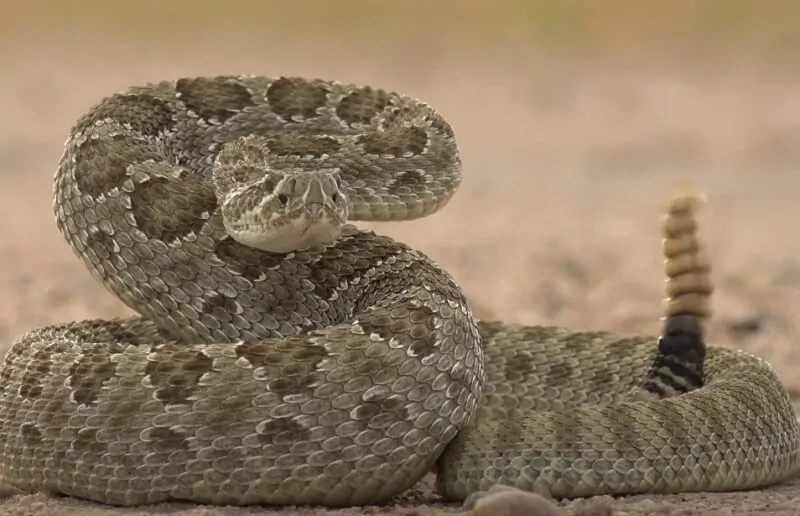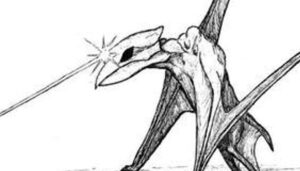If you’re like me, you probably don’t spend your day thinking much about snakes—until one crosses your path, that is. Living in Iowa, there’s a good chance you’ll encounter one of the state’s many snake species at some point.
While some people might feel uneasy about these slithery neighbors, getting to know a few of Iowa’s most common snakes can actually help ease some of that anxiety.
Plus, it’s a great way to gain a new appreciation for the wildlife around us. Let’s take a closer look at some of the most common snakes in Iowa, how to recognize them, and what to expect if you run into one.
Table of Contents
Toggle1. Common Garter Snake (Thamnophis sirtalis)
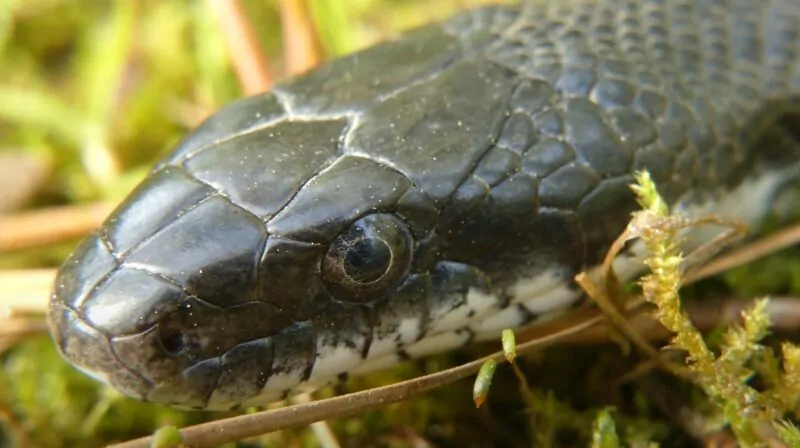
We’re starting with the snake you’re most likely to see. The common garter snake is all over the state and is the type that pops up in your garden or by a pond.
They’re non-venomous and not aggressive, but they might give off a musky smell if they feel threatened.
How to Identify
- Length: 18 to 26 inches
- Color: Dark green or brown with yellow, green, or white stripes running down the length of the body.
- Behavior: Active during the day and generally chill unless provoked. They’re often found near water and are pretty easy-going.
Habitat
Common garter snakes enjoy a mix of environments. They’ll hang out in moist areas like near streams, but you’ll also see them in grasslands, forests, and even suburban backyards.
Keep an eye out next time you’re working in the garden.
2. Plains Garter Snake (Thamnophis radix)
A cousin to the common garter snake, the plains garter snake looks a lot like its relative. Found more often in western and central Iowa, it’s easy to mistake one for the other.
Like its counterpart, it’s non-venomous and harmless.
How to Identify
- Length: 18 to 28 inches
- Color: Olive green or brown with yellow or orange stripes running along the back and sides.
- Behavior: Pretty much like the common garter snake—non-aggressive and peaceful.
Habitat
They prefer open spaces like grasslands and meadows and often hang around wetlands and streams. If you’re out hiking in the west or central parts of Iowa, keep an eye out for these slender snakes.
3. Eastern Fox Snake (Pantherophis vulpinus)
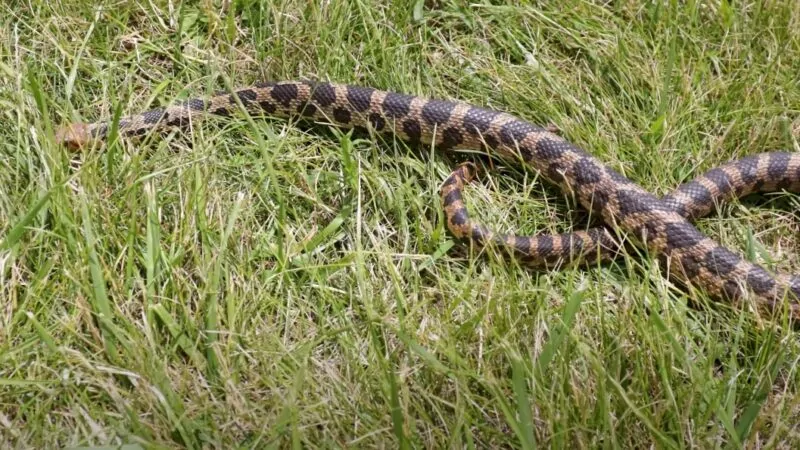
Now, if you come across an eastern fox snake, you might be a little startled by its size—it can grow up to 6 feet long!
Despite its large size, it’s non-venomous and pretty mellow.
How to Identify
- Length: 3 to 6 feet
- Color: Light brown or tan with darker brown blotches on the back and sides.
- Behavior: Eastern fox snakes are known to mimic rattlesnakes by vibrating their tails, but don’t worry—they don’t have a bite to match the bluff.
Habitat
Eastern fox snakes love open spaces, especially near water. Marshes, grasslands, and even agricultural fields are their preferred homes.
They’re great swimmers, so don’t be surprised if you see one near a lake or stream.
4. Black Rat Snake (Pantherophis obsoletus)
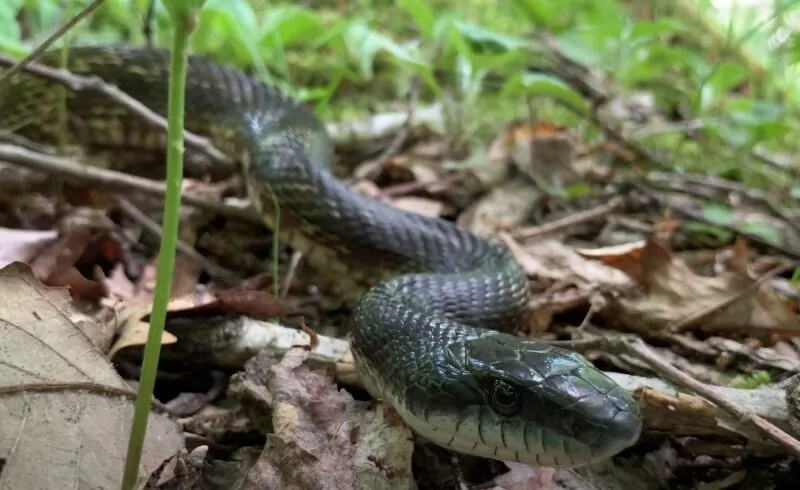
Here’s a snake you’ll want around if you’re not a fan of rodents. The black rat snake is one of the largest in Iowa, and it does an excellent job of keeping the mouse population under control.
How to Identify
- Length: 3 to 5 feet
- Color: Solid black with a lighter underbelly and a few white scales under the chin.
- Behavior: They’re non-aggressive and prefer to stay out of sight. Known for their climbing skills, these snakes are more likely to flee than fight.
Habitat
They tend to stick to forests, woodlands, and agricultural areas. You might also find them around barns or outbuildings since rodents are their main food source.
5. Bullsnake (Pituophis catenifer sayi)
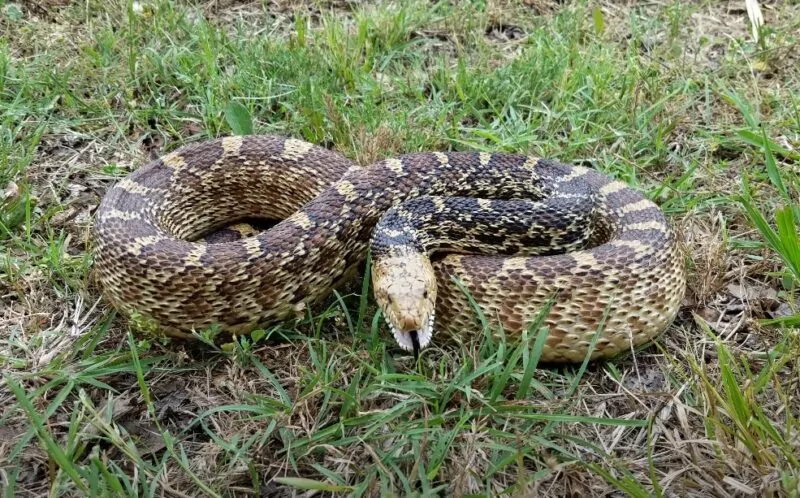
Let’s talk about the biggest snake in Iowa: the bullsnake. At up to 7 feet long, they’re quite the sight, and while they have a bit of a bad rap for being aggressive, they’re actually non-venomous and won’t bother you unless they feel threatened.
How to Identify
- Length: 4 to 7 feet
- Color: Yellow or cream body with brown or black blotches.
- Behavior: They hiss loudly and vibrate their tails, often mistaken for a rattlesnake. But they’re not venomous and are more bark than bite.
Habitat
You’ll find bullsnakes in prairies, farmland, and sandy soils. They also like dry, rocky areas, so if you’re out in the open grasslands, keep an eye out.
6. Northern Water Snake (Nerodia sipedon sipedon)
If you’re near any water in Iowa, chances are good you might spot a northern water snake. Often confused with venomous species like cottonmouths, these non-venomous snakes can be a bit aggressive when cornered, but they’re harmless.
How to Identify
- Length: 24 to 55 inches
- Color: Brown, gray, or reddish with dark crossbands that turn into blotches near the tail.
- Behavior: They’ll bite if they feel threatened, but they’re not dangerous. Mostly, they feed on fish and amphibians.
Habitat
Northern water snakes are almost always found near water—ponds, rivers, lakes, marshes. They love the wet stuff!
7. Ringneck Snake (Diadophis punctatus)
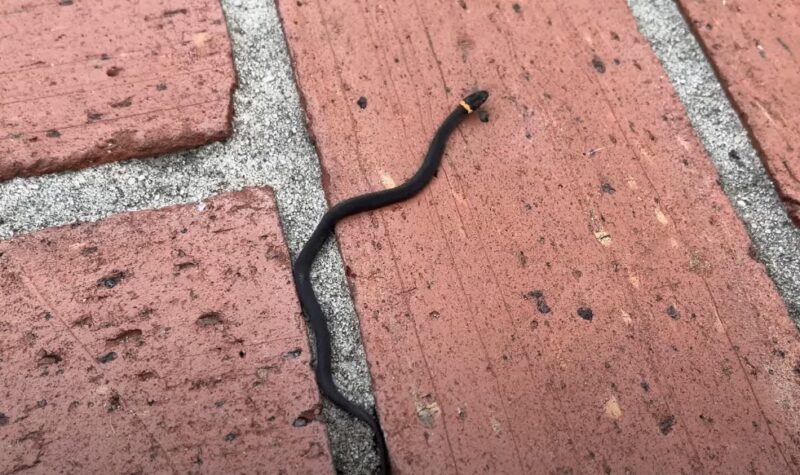
Here’s a snake you might not see too often because it’s small and secretive. The ringneck snake is a nocturnal critter that prefers to keep a low profile.
How to Identify
- Length: 10 to 15 inches
- Color: Dark gray or black with a distinct yellow or orange ring around the neck and a bright underside.
- Behavior: Shy and non-aggressive, they feed mostly on earthworms and insects.
Habitat
They like wooded areas, especially under rocks or logs in moist soil. You’ll have to look closely to spot one since they’re usually out at night.
8. Brown Snake (Storeria dekayi)
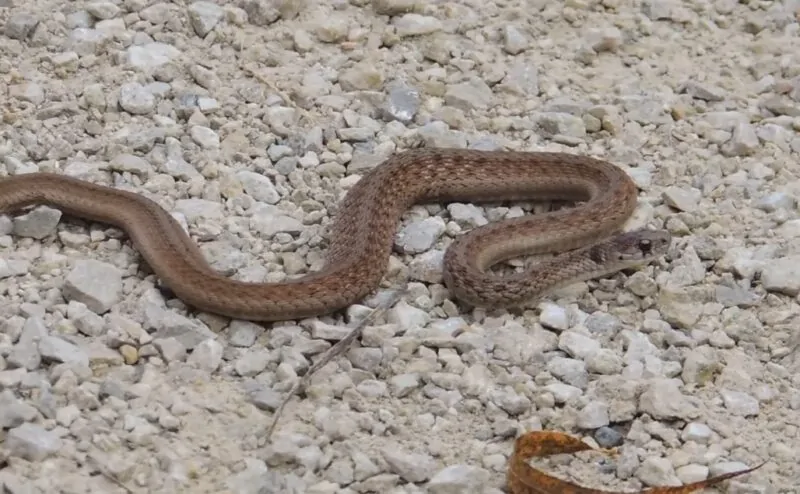
If you live in an urban area, like Des Moines, the brown snake might be the one you’re most likely to see. Small and non-venomous, they blend into their surroundings in residential gardens and parks.
How to Identify
- Length: 9 to 13 inches
- Color: Light brown or gray with small, dark spots on the back and a lighter belly.
- Behavior: These guys are quiet and unassuming. They mainly feed on slugs and worms.
Habitat
They prefer moist areas like gardens and urban parks. You might spot one while tending to your flower beds or walking through a city park.
9. Eastern Hog-nosed Snake (Heterodon platirhinos)
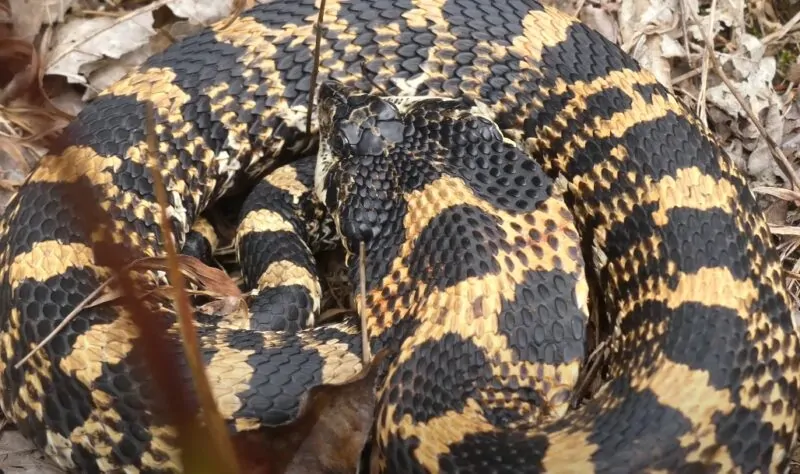
If drama were an Olympic sport, the eastern hog-nosed snake would win gold. When threatened, they put on an impressive show—flattening their necks, hissing loudly, and even playing dead. Despite the theatrics, they’re completely harmless.
How to Identify
- Length: 20 to 35 inches
- Color: Yellow, gray, or brown with dark blotches.
- Behavior: They’ll do everything to look intimidating, but they’re all bluff. Their primary diet is amphibians, particularly toads.
Habitat
Hog-nosed snakes like sandy soils, grasslands, and open woodlands. Keep an eye out if you’re walking through open terrain.
10. Prairie Rattlesnake (Crotalus viridis)
Now, let’s talk about the one venomous snake on our list: the prairie rattlesnake. While they’re rare in Iowa and tend to stick to the western parts of the state, particularly the Loess Hills, it’s still important to know what to look for.
How to Identify
- Length: 35 to 45 inches
- Color: Light brown or greenish with dark blotches and a distinctive rattle on the tail.
- Behavior: Prairie rattlesnakes are venomous and should be avoided. They won’t go out of their way to bother you, but they will defend themselves if threatened.
Habitat
They prefer rocky areas and grasslands, mainly in western Iowa. If you’re hiking in the Loess Hills, be mindful of where you step.
Final Words
Getting familiar with Iowa’s snake species can make encounters far less intimidating. While some, like the prairie rattlesnake, deserve a wide berth, the majority are non-venomous and play a helpful role in keeping the ecosystem balanced.
So, next time you cross paths with a slithery friend, maybe take a moment to appreciate the role they play in nature—even if you prefer to do it from a safe distance!


